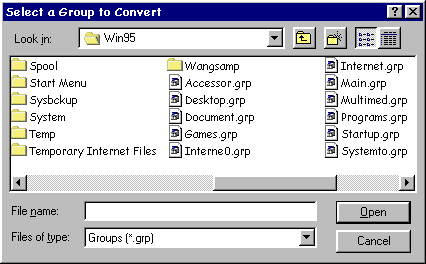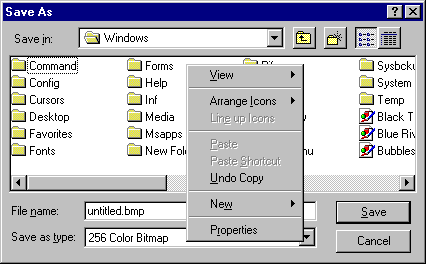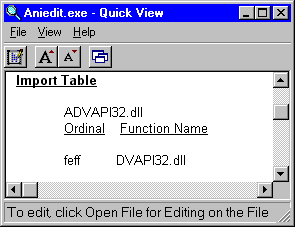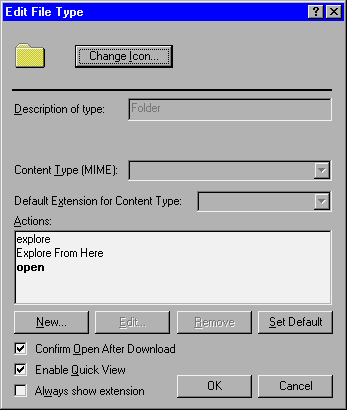|
In Basic Windows 95 Tips, Part 1 and Part 2, we talked about some easy Windows 95 tips and tricks that help make your life easier, more efficient and more fun. Now we'll move on to some "power" tips to help you even more. Many of these tips are undocumented, but I find them useful nonetheless. I think you will, too.
Emptying the documents folder on the Start button Emptying the documents folder on the Start buttonClick the Start button, select Taskbar from the Settings folder (or alternately, right-click the Taskbar and select Properties). On the 'Start Menu Programs' page, click Clear. The files you see listed now are left from opening documents in Windows 95-aware applications via Explorer. Any older 16-bit files will not show up here. They are stored in a hidden folder under Windows called \RECENT. Deleting the files in this folder will not only accomplish the same thing, but it will also let you be more selective about which files stay and which go. Changing folder iconsOpen any folder, and from the View menu select Options. In the Options dialog box, select the File Types tab and scroll down the list of Registered File Types to the Folder item. Select the Folder item, click Edit, then click the Change Icon button. Select a new icon. Be advised, however, that this invokes a global change and all of your folders will take on this new look. Converting old program groupsYou can manually (after setup) convert old Windows 3.x program groups in one of two ways: The first is to double-click on any .GRP file, and it will automatically convert the program group to a new Programs folder, which you'll then find on the Start button. Windows 95 comes equipped with a .GRP file conversion utility called GRPCONV.EXE, which is automatically associated with .GRP files. This utility can be found in your \Windows folder. Another, perhaps better, way is to choose the Run command on the Start button and enter: GRPCONV /M. This switch will provide you with a dialog box that searches your \Windows folder for all .GRP files, allowing you to select which groups you would like to convert. See the screen capture below.
Left mouse button drag and dropYou have no doubt by now discovered that you get some very different actions during file operations depending on whether you use the right or left mouse button. I prefer to use the right mouse button because it's harder to make a mistake when you're presented with a drop-down menu, which you always get using the right button. But for those of you who want to understand the differences, here's what the left button does. Left-dragging objects from one directory to another on the same drive results in a move. Holding down Shift while using left-drag forces a move. Left-dragging objects from one directory to another on a different drive results in a copy. Holding down Ctrl while using left-drag forces a copy regardless of the source or destination. Left-dragging an executable file to a new directory results in a shortcut to that file. Right-dragging any object from one directory to another, then selecting the Create Shortcut(s) Here option, will result in a shortcut to that object. Small annotations on the icons while dragging will indicate the drop behavior: a plus sign for copy, a hooked arrow for a shortcut, and no symbol for a move. Pressing Esc in the middle of a drag aborts it. Right mouse button drag and dropRight-drag and drop works like left-drag and drop except that when you drop, you are given a menu of choices depending on the object itself. For Folders, you'll see Move Here, Copy Here and Create Shortcut(s) Here. For OLE Objects, you'll see Create Scrap Here, Move Scrap Here and Create Document Shortcut(s) Here. I always recommend that new users get used to using right drag and drop for all file operations as it is much easier than trying to remember the various behaviors of left drag and drop, and, besides, I like the fact that I always get a menu this way. I don't know how many times I've used the left mouse button for file operations, only to have a file seemingly disappear while I wondered where it went. Dragging an object to a covered windowIf you want to open another file in an application that is already running but covered up by other windows, drag the object over the application's button on the Taskbar and hold it there for a second. The application window will come to the top allowing you to drop the object into the application without rearranging the other open windows. Dragging an object to a minimized applicationIf you want to open another file in an application that is already running but minimized, simply drag the object over the application's minimized button on the Taskbar and hold it there for a second. The application will reopen, allowing you to drop the new file onto it for use in that session. Opening additional windows in single-window browse modeIn any Explorer window, if your View/Options are set to 'Browse Folders Using a Single Window for Each Folder,' you can open an additional window for the folder by holding Ctrl while you double-click. How to NOT start the Startup folderHold down the Ctrl key while starting Windows. This will keep items in the Startup folder from launching. Extract TricksHave you ever had to use the old EXPAND.EXE command in Windows 3.x to reinstall or copy a compressed file from the disks? In Windows 95 there's a decompression utility called EXTRACT.EXE, and it's just as useful, maybe even more so. EXTRACT.EXE can be found in your \Windows folder or on the CD under \WIN95, or if you bought the disk set, on Disk No. 1. Go to a prompt and type extract /? for more details. Here's an example of how you would use this utility from a command prompt: EXTRACT /A /L C:\WINDOWS\SYSTEM ?:\WIN95\WIN95_02.CAB MIDIMAP.DRV This particular syntax searches all .CAB files beginning with no. 2 and installs that one file into the directory of your choosing (in this case, midimap.drv is being copied to c:\windows\system). Make sure to substitute your CD drive where you see "?". Wildcards can be used in case you wanted to, say, recopy all the .BMP's from the CD. If you have disks, you need to know which .CAB file is on each disk, or you may end up searching them all if you don't know where the file is. More Extract-ionsHere's another great Extract tip. Would you like to know exactly which files were in all the various compressed .CAB files on the CD and where? Write this simple batch file to produce a report showing all files in the Windows 95 .CABs and create a permanent record in a text file. for %%x in (?:\win95\*.cab) do extract /d %%x >> C:\cabfile.txtedit C:\cabfile.txt Make sure you type it as shown (on two lines, the first starting with 'for' and the second beginning with 'edit') and substitute your CD drive letter where you see the "?". Also specify the path and filename for your report. In the above example, the report will be saved as CABFILE.TXT and will be located on C:\. As an example, save this batch file as CABFILE.BAT. Add a new Cascading Control Panel to the Start buttonWant a great shortcut for getting to your Control Panel modules without having to click through Start /Settings /Control Panel? Or just want to load one particular item? There are a couple of ways to do this. Here's one: Here's another: Put this all on one line, and be sure to include the period (.), the curly braces, all four hyphens, and the hex numbers as shown. After doing this, you'll get a folder in your Start Menu called Control Panel with a cascading menu with all of the Control Panel modules in it. It's a real timesaver. You can also do the same with the following system folders:
Dial-Up Networking.{992CFFA0-F557-101A-88EC-00DD010CCC48} Freeing disk spaceIf you don't need all the extra animation in your Help files, you can free up just over 7M bytes of hard drive space by deleting the .AVI files from /Windows /Help if you originally chose to install the Online User's Guide. Also, if you upgraded over an existing copy of Windows 3.x, there will be a choice under Control Panel--Add/Remove Programs to Delete old DOS and Windows files. This option will clean out any unnecessary Windows 3.x system files and remove your old DOS directory as well. Right-clicking in 'Save As' dialog boxesTry it! If you are saving a file and right-click in the dialog box, you can change your view, arrange the icons, or create new folders prior to saving the file. This is great if you suddenly decide while saving that you want to save the file in a folder that doesn't currently exist. See below.
Seeing PropertiesTo quickly access the Properties information for any object, hold the Alt key while double-clicking it, as opposed to digging through the dropdown menu. What .DLLs are being used in a .EXE?Right-click on an application's .EXE filename and select QuickView. Look for the Import Table information. This feature might be useful if you want to clean up unnecessary files, and you suspect a particular .DLL is no longer needed by other applications. See below.
Reducing desktop window clutterIf you've opened many windows under My Computer (assuming you're set up for Separate Window Browse under View/Options), you can quickly close them all by holding the Shift key while clicking the close-window box on the topmost window. Disable AutoPlay for audio CDsTo disable AutoPlay from automatically playing an audio CD, hold the Shift key for a few seconds after you close the CD-ROM drive door. Soundcard volume controlSingle-click the speaker icon in the Taskbar tray to bring up the master volume control. Double-click that icon to bring up the full mixer controls. While you're in here, check out Options /Properties. You can setup the Volume Control for your PC speaker and even an attached microphone. Dial-up networking Auto-RedialBring up the Dial-Up Networking Folder in My Computer, highlight the connection, then select Connections /Settings. This is especially useful when connecting to your Internet service provider. If yours is anything like mine, you get a lot of busy signals. Add some speed to Windows 95 BackupThe Backup applet that ships with Windows 95 (located in the System Tools folder if you installed it) may run up to 15% to 25% faster if you keep it minimized during the backup. Easy clock/calendar changesDouble-click the clock in the Taskbar tray to see a calendar and change the system date/time. Make a shortcut to a specific point in any documentDid you know that you can drag a paragraph from a Word document or a single cell from an Excel worksheet and drop it anywhere to create an instant shortcut to that information just as you would for any object? Right-drag a selection from any OLE document onto the Desktop or folder, then select the 'Create Document Shortcut Here' item, and a shortcut (bookmark) will be created. Opening this document shortcut at a later time will open the original document and return you to the place in the document that the shortcut originated. You could take that shortcut and e-mail it to, say, a co-worker on the network. When the recipient double-clicks it, it will open the spreadsheet, scroll to that cell, and select it. Drag and drop from the File Open/Find dialog boxFrom the File Open dialog box of any Windows 95 application (or even F3 for the Find dialog box), you can drag and drop documents or folders onto the Desktop, into Explorer, or anywhere else that handles objects, including Exchange e-mail. Change the default behavior of foldersRight now, when you double-click a folder it will simply open showing the contents inside in a separate window. Would you like Folders to open in an Explorer view instead, complete with the directory structure in the left pane? Easy! Open Explorer, select View|Options|File Types from the menu and scroll down in the Registered File Types window to Folder. Highlight it and click Edit, you should see a window similar to the one shown below. As you can see in the Actions window, 'open' is boldfaced, designating it as the default action. Just highlight 'explore' and click Set Default. From now on all your Folders will open in Explorer view with a double-click.
Multiple associationsIn Basic Tips - Part 1 we talked about using the SendTo folder to allow you to launch an associated file type with a different application. Here's another way. Let's say you want to be able to open .TXT documents in either Notepad or Wordpad. Open Explorer and go to View|Options|File Types again. Find the Text Document type in the Registered File Types window, choose Edit to edit that type, and you'll see that the Actions list includes Open and Print. You'll want a new action so choose New. You'll see the New Action dialog box. Call the action "Open in WordPad", and click the Browse button to choose WordPad as the application that needs to perform the action. From now on whenever you right-click a .TXT file, you'll get this new action on the dropdown menu. I've used this method to re-establish associations that were overwritten by installing other applications. For instance, Word took control of .DOC and .RTF files after it was installed. I still like to have .RTFs associated with WordPad for speed reasons, so I added an "Open in WordPad" action to the Microsoft Word Document (.DOC) association. There's moreThe tips and tricks described here are just the beginning. As you can see, customizability is one of the more powerful tools that makes Windows 95 so useful. You can set your machine up exactly the way you want it to be for the way you like to work. You can set up the cascading menus from the Start button, make changes to the dropdown menus and use shortcuts for everything, even pasting into e-mail. If you don't like the default behavior of an object, change it. File operations can be performed from any Save, Save As or Find dialog. Try these tips and see how many more you can discover on your own. After all, isn't that part of the fun?  Return to Top of Page Return to Top of Page
To Main Page |
Start Me Up! Best experienced with All other product names are trademarks or registered trademarks of their respective owners. |
 In this Issue:
In this Issue:



